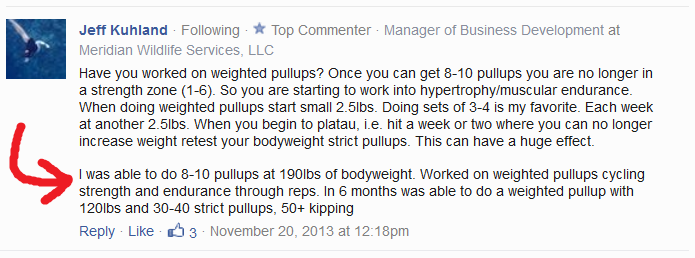Break Your Pull-up Training Plateau and Work Your Way up to Doing Sets of 20-30+ Pull-ups Using These Tips From Jeff “50+ Pull-ups” Kuhland

I got a chance to train with Jeff Kuhland at a 5-day MovNat retreat back in 2009, and have kept in touch with him off and on ever since. Jeff is not only a wealth of training knowledge, but he is also a humble coach, too. I actually interviewed him last year all about his approach to training, and about MovNat, in particular (click here to check out the first interview). So, I won’t rehash his long list of accomplishments and credentials today.
Now, in this interview, our topic was strictly pull-ups and chin-ups. You see, I read an article that Jeff wrote for BreakingMuscle.com all about his unique approach to pull-up training. He shared some really good tips and a few interesting ideas in that article, but what really caught my attention was one of his responses to a comment on that page. Someone was asking for advice on breaking through a pull-up training plateau, and Jeff replied…

Naturally, this piqued my curiosity, not only because of Jeff’s impressive accomplishment, but also because of the distinction between training for pull-up strength versus training for endurance – and how the strength training needs of an athlete change as they start building their numbers. This is an approach that I’ve used myself, but is rarely shared in detail online. And I wanted to get to the bottom of it from someone who knows.
So, after a month of playing “email tag” trying to find a time that worked for both of us, we finally got on the phone and made it happen.
Now, on this call, I learned that Jeff and I have a lot in common when it comes to pull-up training, but that we also do a few things very differently. And that’s one of the reasons why I love doing these interviews, because I learn so much, too – and I try to make it a point to challenge my beliefs about training once in awhile. And you might find that’s the case when you listen to this interview because Jeff is anything but traditional when it comes to training.
Now, even though this interview had quite a specific topic, we actually covered a lot of broad information in a short period of time. And there were many times when I was on the line, making notes of other things to discuss that we never actually got to in the time we had available.
So, what can you learn from Jeff Kuhland today?
- How to increase your strength to weight ratio and build your pull-up numbers
- Jeff’s 3 go-to methods for dramatically increasing pull-up reps to high rep sets (e.g. 30+ reps)
- Why intermediate and advanced trainees often need to train for pull-up strength to increase endurance capacity if they want to build up to very high rep sets of pull-ups
- Jeff’s formula for breaking a pull-up training plateau
- A better alternative to Crossfit-style kipping pull-ups
- why Jeff thinks a wide variety of training is important and how to apply that to pull-up training
- a basic progression for working up to one-arm pull-ups
- the best equipment for effective pull-up training
- how to make your pull-up training more practical for real-life climbing purposes using the lessons he’s learned from his MovNat experience and a collection of practical pull-up variations such as the tap swing, tuck swing, and elbow pull-ups
- Jeff’s favorite pull-up workouts
- and much more!
Seriously, those bullets are just the tip of the iceberg. Some of my interviews have flowed very smoothly from question to question. But this time, it was almost like each time Jeff answered a question, I had even more questions and wanted to highlight something specific he said that struck me a certain way. And sometimes, I had to hold my tongue to keep myself from interrupting him to dig a little deeper. But in the interest of keeping the interview under an hour, I tried to keep it moving along, too. So, my point being that when I said we covered a lot, we did – even in just 50 minutes.
So, if you’re interested in getting better at pull-ups and chin-ups, and particularly, in working your way up to high repetition sets (20-30+ repetition range), then, have a listen! And even if you’re not keen on increasing your pull-up performance, but would like to learn some expert insights about strength and conditioning, in general, then I think you’ll enjoy this interview, too.
Update: This interview is now only available as part of The Pull-up Solution package here: The Pull-up Solution.
*Mp3 audio file, approximate length is 50 minutes
Wrap Up
I want to offer a big thanks to Jeff for taking the time to do this interview. He has recently taken a new job and has had a very busy schedule since, and I wanted to thank him for making this interview a priority. If you’re interested in learning more about Jeff and his work, be sure to check out his website at www.athletichuman.com.
And if you’re interested in getting better at pull-ups and chin-ups, then check out my free 5-day Pull-up Training Crash Course, which is available on my other website here: Pull-up Training Crash Course.
If you found this article helpful, please share it with your friends:
.jpg)
![]()
Health-First Fitness Coach
P.S. If you liked this post, then please signup for the newsletter, or follow me on Facebook or Twitter for daily updates and other interesting info.

Huge +1 for weighted pull-ups here.
After messing around in the 10 – 15 rep range at 195lbs I chucked on a weight belt and have since been focusing on the 4- 6 rep range which has not only resulted in increased strength but back thickness has dramatically increased over time.
If you were like me and focusing on high rep bodyweight pull-ups slap a 45lb plate on a weight belt and hit those low reps!
Right on, SJ.